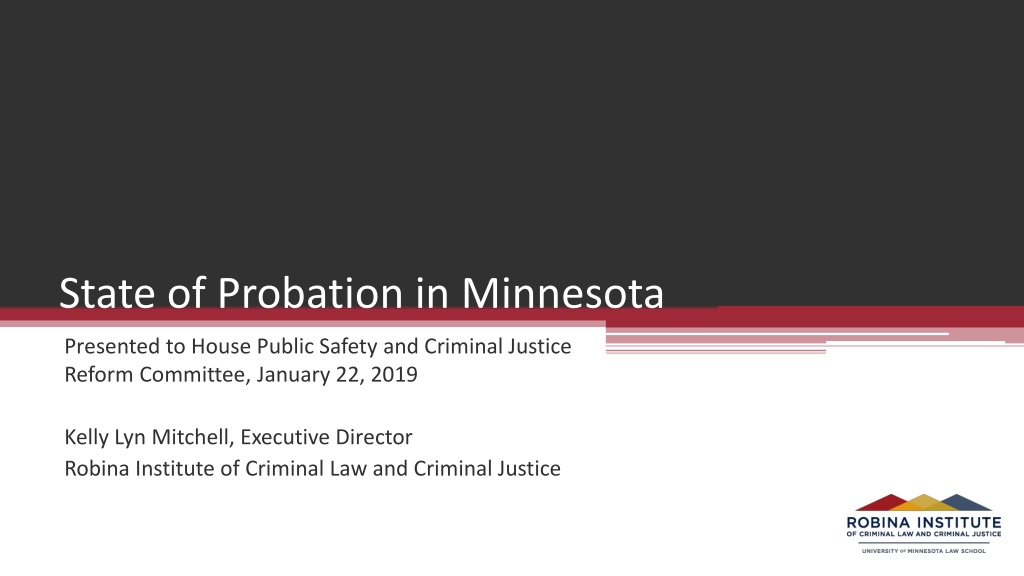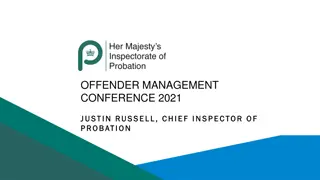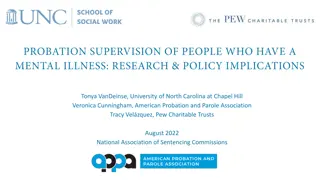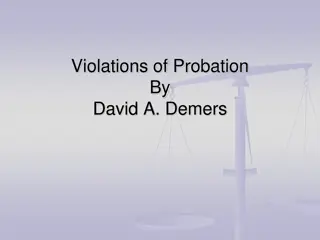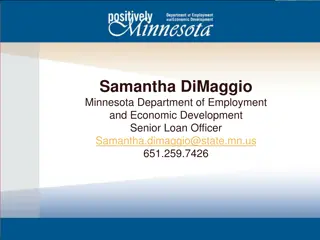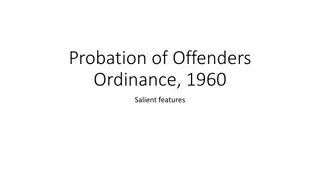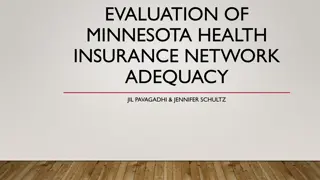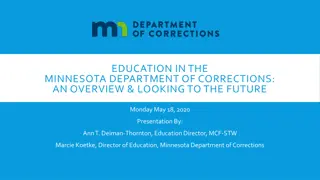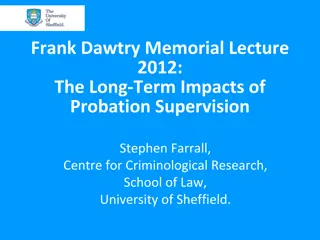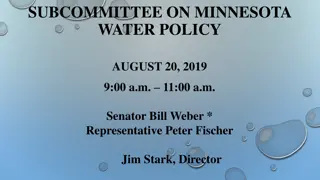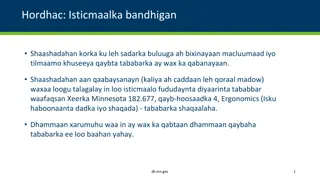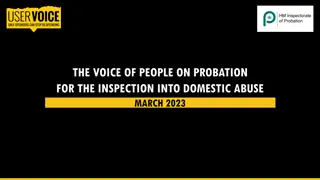State of Probation in Minnesota
The presentation on the state of probation in Minnesota showcases key statistics related to incarceration rates, correctional supervision, community supervision, and probation population trends from 1996 to 2017. It highlights Minnesota's approach to probation and its comparison to national data on correctional control. The emphasis is on understanding the state's unique position in managing probation and its impact on the criminal justice system.
Download Presentation

Please find below an Image/Link to download the presentation.
The content on the website is provided AS IS for your information and personal use only. It may not be sold, licensed, or shared on other websites without obtaining consent from the author.If you encounter any issues during the download, it is possible that the publisher has removed the file from their server.
You are allowed to download the files provided on this website for personal or commercial use, subject to the condition that they are used lawfully. All files are the property of their respective owners.
The content on the website is provided AS IS for your information and personal use only. It may not be sold, licensed, or shared on other websites without obtaining consent from the author.
E N D
Presentation Transcript
State of Probation in Minnesota Presented to House Public Safety and Criminal Justice Reform Committee, January 22, 2019 Kelly Lyn Mitchell, Executive Director Robina Institute of Criminal Law and Criminal Justice
2 Minnesota Has a Reputation for Low Incarceration Rates 5th Lowest Incarceration Rate Source: Bureau of Justice Statistics, Correctional Populations in the United States, 2016, http://www.bjs.gov/index.cfm?ty=pbdetail&iid=6226 Rank (2016) State Incarceration Rate (per 100,000 adults 18 and over) 1 Oklahoma 1310 47 Minnesota 380 48 Rhode Island 370 49 Massachusetts 360 50 Vermont 340 51 District of Columbia 320
3 13th Highest Rate of Correctional Control Rank (2016) State Correctional Supervision (per 100, 000 adults over 18) But the Overall Rate of Correctional Control Is Much Higher 1 Idaho 3880 Source: Bureau of Justice Statistics, Correctional Populations in the United States, 2016, http://www.bjs.gov/index.cfm?ty=pbdetail&iid=6226 2 Pennsylvania 3640 3 Ohio 3620 4 Texas 3290 5 Arkansas 3150 5 Indiana 3150 7 Louisiana 3110 8 Delaware 2980 9 Mississippi 2880 10 Kentucky 2850 10 Rhode Island 2850 12 Colorado 2820 13 Minnesota 2810
4 The Overall Correctional Control Rate is Driven by the Community Supervision Rate 5th Highest Community Supervision Rate Source: Bureau of Justice Statistics, Correctional Populations in the United States, 2016, http://www.bjs.gov/index.cfm?ty=pbdetail&iid=6226 Rank (2016) State Community Supervision Rate (per 100,000 adults over 18) 1 Idaho 2980 2 Pennsylvania 2880 3 Ohio 2840 4 Rhode Island 2730 5 Minnesota 2450
5 Minnesota Probation Population 1996-2017 Source: MN Dept. of Corrections, 2017 Probation Survey, https://mn.gov/doc/assets/2017%20Probation%20Survey%20Final_tcm1089-335645.pdf 140,000 127,797 120,000 98,830 100,000 88,039 80,000 60,000 40,000 20,000 0 2006 1996 1997 1998 1999 2000 2001 2002 2003 2004 2005 2007 2008 2009 2010 2011 2012 2013 2014 2015 2016 2017 Felony Gross Misdemeanor Misdemeanor Total Adult Probation
6 Minnesota Probation Population 1996-2017 Source: MN Dept. of Corrections, 2017 Probation Survey, https://mn.gov/doc/assets/2017%20Probation%20Survey%20Final_tcm1089-335645.pdf 60,000 48,402 50,000 45,549 39,930 40,000 31,344 27,373 30,000 21,937 20,736 20,000 10,000 0 2008 1996 1997 1998 1999 2000 2001 2002 2003 2004 2005 2006 2007 2009 2010 2011 2012 2013 2014 2015 2016 2017 Felony Gross Misdemeanor Misdemeanor
7 Prison is Reserved for the Most Serious Offenses and Offenders 4. Commitment to the Commissioner of Corrections is the most severe sanction that can be imposed for a felony conviction, but it is not the only significant sanction available to the court. 5. Because state and local correctional facility capacity is finite, confinement should be imposed only for offenders who are convicted of more serious offenses or who have longer criminal histories. To ensure such usage of finite resources, sanctions used in sentencing convicted felons should be the least restrictive necessary to achieve the purposes of the sentence. Minn. Sentencing Guidelines 1.A.4 and 1.A.5 (2018).
8 Number of Individuals Sentenced to Prison vs. Probation for Felonies (2001-15) replace with MSGC numbers? Source: MSGC, Probation Revocations: Offenders Sentenced from 2001-2015 and Revoked to Prison Through 2016, http://mn.gov/msgc- stat/documents/reports/2016/2016MsgcPro bationRevocationsReport.pdf
9 Maximum Probation Terms Set in Statute Offense Level Maximum Probation Term Felony 4 years or statutory maximum, whichever is longer 6 years Gross Misdemeanors (DWI and criminal vehicular operation) Gross Misdemeanors (all others) 2 years Misdemeanors (DWI, domestic assault, certain others related to stalking) 2 years Misdemeanors 1 year
10 Average Probation Length by Judicial District (2010-15) 100 Average Length of Probation (mos.) 86 90 81 79 79 75 80 73 69 70 58 60 50 39 38 40 30 20 10 0 1 2 3 4 5 6 7 8 9 10 Judicial District
11 Breakdown of Probation Terms by Judicial District (2010-15) 3% 4% 15% 10% 18% 13% 18% 22% 24% 27% 27% 28% 30% 4% 1% 45% 44% 60% 66% 56% 65% 54% 62% 56% 58% 56% 2% 2% 24% 25% 0% 2% 1% 1% 13% 1% 14% 11% 4% 4% 10% 14% 15% 9% 4% 12% 6% 8% 8% 6% 5% 5% 4% 3% 3% 1 2 3 4 5 6 7 8 9 10 STATE Judicial District 1 year 2 years 3 years 4 years 5 years Over 5 years
12 Breakdown of Probation Terms Longer Than 5 Years (2010-15) 2 2 4 14 5 54 20 88 86 882 62 126 235 205 9 82 168 58 221 1589 100 316 115 277 360 164 39 238 1186 97 165 178 167 310 142 1033 1260 308 1937 8797 562 1010 999 1236 1 2 3 4 5 6 7 8 9 10 STATE Judicial District 10 yrs 15 yrs 20 yrs 25-40 yrs
13 Probation Lengths by Offense Type (2010-15) Average probation terms >5 years by offense type (2010-15) Average probation terms by offense type (2010-15) 200 90 176 79 79 180 77 80 159 155 160 70 64 137 140 59 123 60 120 50 100 85 37 40 80 30 60 20 40 20 10 0 0 person property drugs DWI Weapons Other person property drugs DWI Weapons Other
14 What we know Minnesota prioritizes probation over prison The felony probation population has overtaken misdemeanor probation population and is continuing to grow Felony probation terms are longer than misdemeanor probation terms Because there is little guidance in the statute with which to calibrate felony probation terms, there is a great deal of variation in probation terms both by geography and offense type
15 What we don t know How long are people actually serving on probation? To what extent are probation terms being extended for failure to pay restitution or failure to complete treatment? Can extend for 1 year, up to two times to promote restitution payment Can extend for up to 3 years to promote treatment completion How often are individuals stepping up to a stay of execution from a stay of imposition? To what extent is early discharge being used across the state? Are there pockets where it is not being used at all? Recidivism rates how many probationers are convicted of new crimes?
16 What we don t know (cont d) How many probationers are revoked for reasons other than a new felony? How many probation violations do not result in revocation? Why probationers fail Most failures occur during the first two years on probation, so that s the time to focus our resources
17 Questions? Kelly Lyn Mitchell Robina Institute of Criminal Law and Criminal Justice mitch093@umn.edu 612-626-4736
